QAB020C414S: Imperial Hotel Management: Solution to Work Culture
VerifiedAdded on 2023/04/24
|10
|2750
|389
Report
AI Summary
This report provides a comprehensive management solution for addressing the negative work culture and poor guest satisfaction at the Imperial Hotel. The report begins by introducing the problem, highlighting issues such as poor attendance and low employee morale. It then explores various theoretical frameworks, including Lewin's change management model and Maslow's hierarchy of needs, to identify and analyze the root causes of the problem. The report proposes practical solutions such as employee training programs, flexible management practices, and the encouragement of appropriate sick leave usage. Furthermore, the report advocates for the adoption of a democratic management style to foster better communication and employee involvement. The conclusion summarizes the key findings and emphasizes the importance of implementing these recommendations to improve the hotel's performance and create a more positive work environment.
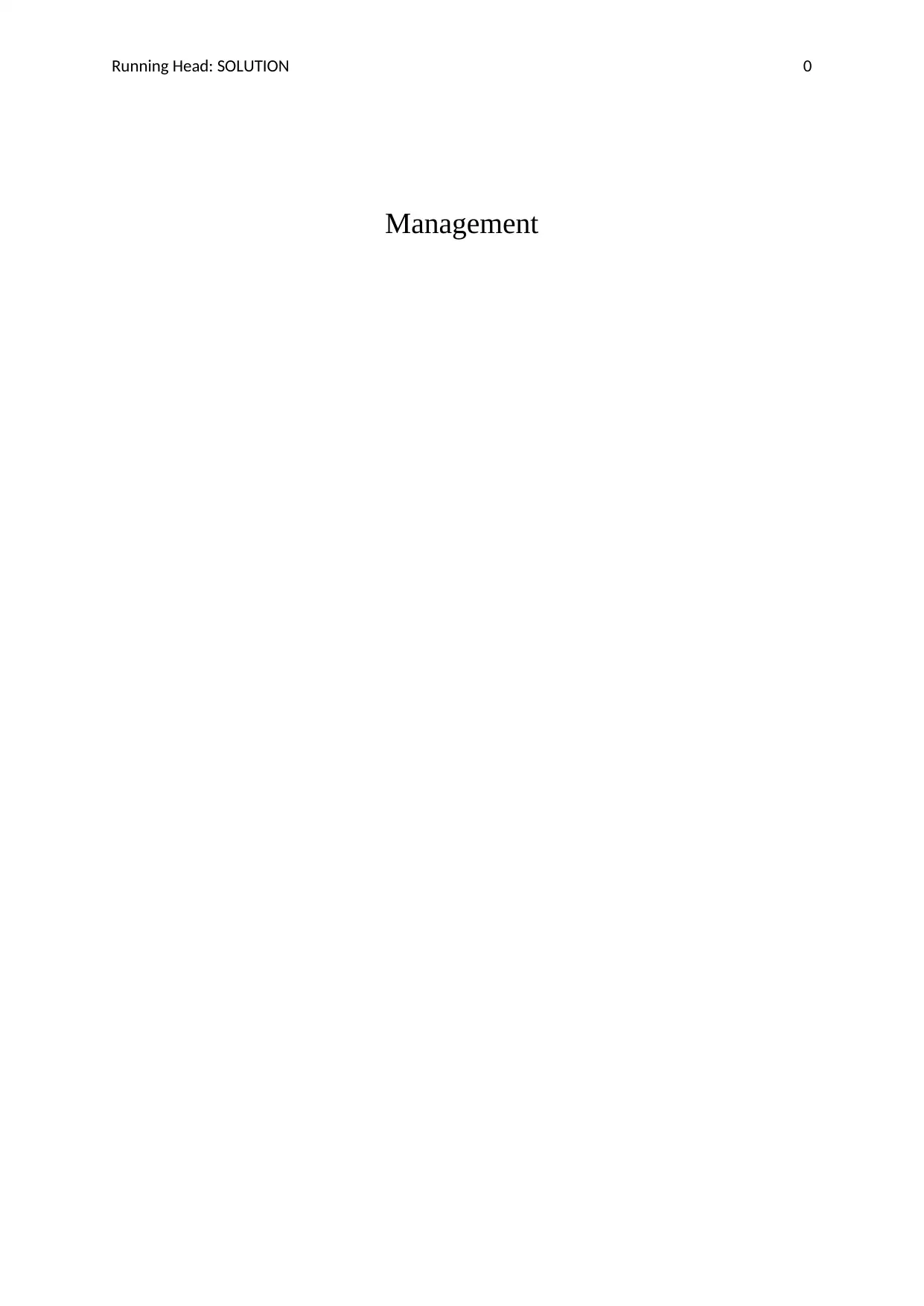
Running Head: SOLUTION 0
Management
Management
Paraphrase This Document
Need a fresh take? Get an instant paraphrase of this document with our AI Paraphraser
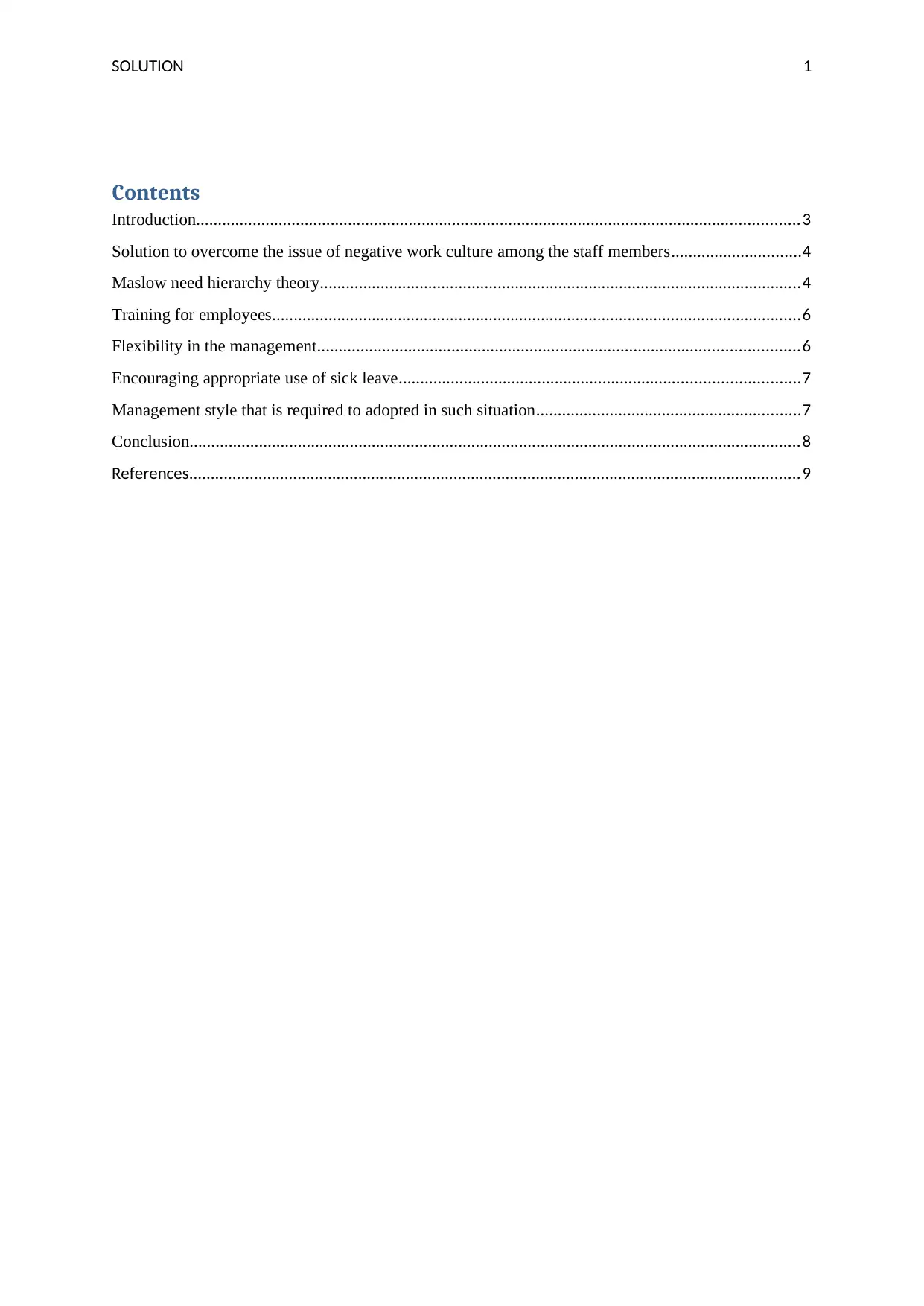
SOLUTION 1
Contents
Introduction...........................................................................................................................................3
Solution to overcome the issue of negative work culture among the staff members..............................4
Maslow need hierarchy theory...............................................................................................................4
Training for employees..........................................................................................................................6
Flexibility in the management...............................................................................................................6
Encouraging appropriate use of sick leave............................................................................................7
Management style that is required to adopted in such situation.............................................................7
Conclusion.............................................................................................................................................8
References.............................................................................................................................................9
Contents
Introduction...........................................................................................................................................3
Solution to overcome the issue of negative work culture among the staff members..............................4
Maslow need hierarchy theory...............................................................................................................4
Training for employees..........................................................................................................................6
Flexibility in the management...............................................................................................................6
Encouraging appropriate use of sick leave............................................................................................7
Management style that is required to adopted in such situation.............................................................7
Conclusion.............................................................................................................................................8
References.............................................................................................................................................9
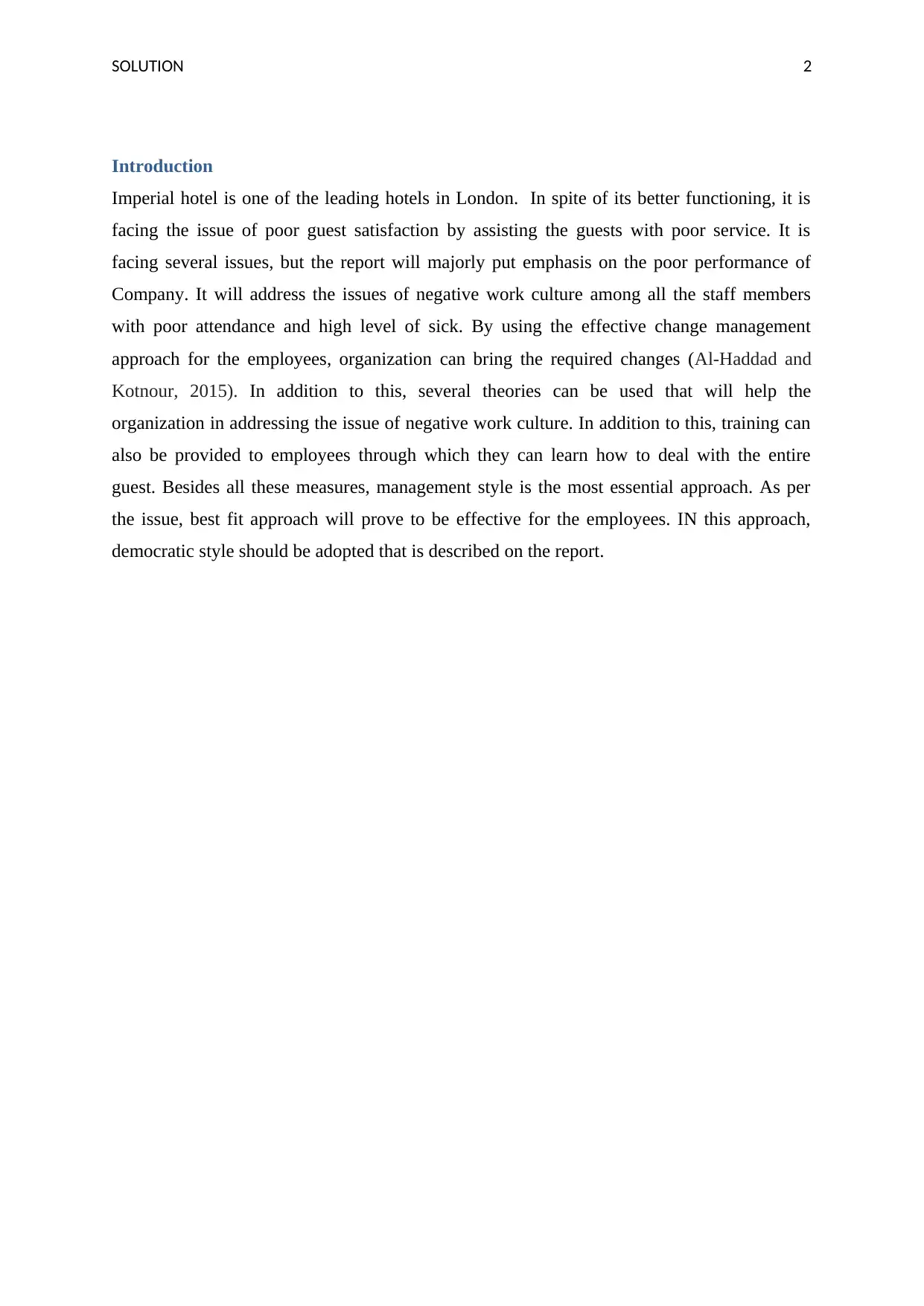
SOLUTION 2
Introduction
Imperial hotel is one of the leading hotels in London. In spite of its better functioning, it is
facing the issue of poor guest satisfaction by assisting the guests with poor service. It is
facing several issues, but the report will majorly put emphasis on the poor performance of
Company. It will address the issues of negative work culture among all the staff members
with poor attendance and high level of sick. By using the effective change management
approach for the employees, organization can bring the required changes (Al-Haddad and
Kotnour, 2015). In addition to this, several theories can be used that will help the
organization in addressing the issue of negative work culture. In addition to this, training can
also be provided to employees through which they can learn how to deal with the entire
guest. Besides all these measures, management style is the most essential approach. As per
the issue, best fit approach will prove to be effective for the employees. IN this approach,
democratic style should be adopted that is described on the report.
Introduction
Imperial hotel is one of the leading hotels in London. In spite of its better functioning, it is
facing the issue of poor guest satisfaction by assisting the guests with poor service. It is
facing several issues, but the report will majorly put emphasis on the poor performance of
Company. It will address the issues of negative work culture among all the staff members
with poor attendance and high level of sick. By using the effective change management
approach for the employees, organization can bring the required changes (Al-Haddad and
Kotnour, 2015). In addition to this, several theories can be used that will help the
organization in addressing the issue of negative work culture. In addition to this, training can
also be provided to employees through which they can learn how to deal with the entire
guest. Besides all these measures, management style is the most essential approach. As per
the issue, best fit approach will prove to be effective for the employees. IN this approach,
democratic style should be adopted that is described on the report.
⊘ This is a preview!⊘
Do you want full access?
Subscribe today to unlock all pages.

Trusted by 1+ million students worldwide
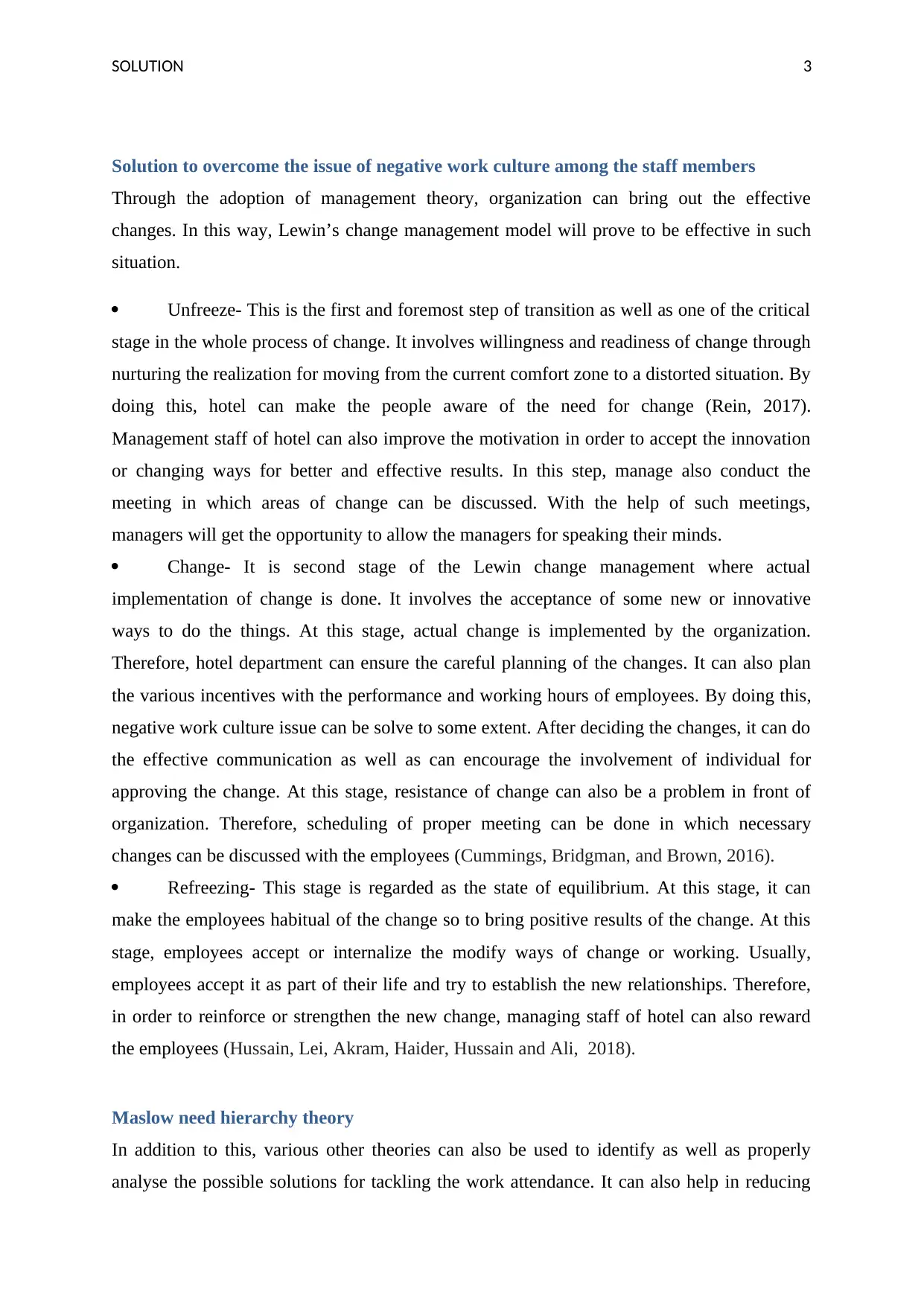
SOLUTION 3
Solution to overcome the issue of negative work culture among the staff members
Through the adoption of management theory, organization can bring out the effective
changes. In this way, Lewin’s change management model will prove to be effective in such
situation.
Unfreeze- This is the first and foremost step of transition as well as one of the critical
stage in the whole process of change. It involves willingness and readiness of change through
nurturing the realization for moving from the current comfort zone to a distorted situation. By
doing this, hotel can make the people aware of the need for change (Rein, 2017).
Management staff of hotel can also improve the motivation in order to accept the innovation
or changing ways for better and effective results. In this step, manage also conduct the
meeting in which areas of change can be discussed. With the help of such meetings,
managers will get the opportunity to allow the managers for speaking their minds.
Change- It is second stage of the Lewin change management where actual
implementation of change is done. It involves the acceptance of some new or innovative
ways to do the things. At this stage, actual change is implemented by the organization.
Therefore, hotel department can ensure the careful planning of the changes. It can also plan
the various incentives with the performance and working hours of employees. By doing this,
negative work culture issue can be solve to some extent. After deciding the changes, it can do
the effective communication as well as can encourage the involvement of individual for
approving the change. At this stage, resistance of change can also be a problem in front of
organization. Therefore, scheduling of proper meeting can be done in which necessary
changes can be discussed with the employees (Cummings, Bridgman, and Brown, 2016).
Refreezing- This stage is regarded as the state of equilibrium. At this stage, it can
make the employees habitual of the change so to bring positive results of the change. At this
stage, employees accept or internalize the modify ways of change or working. Usually,
employees accept it as part of their life and try to establish the new relationships. Therefore,
in order to reinforce or strengthen the new change, managing staff of hotel can also reward
the employees (Hussain, Lei, Akram, Haider, Hussain and Ali, 2018).
Maslow need hierarchy theory
In addition to this, various other theories can also be used to identify as well as properly
analyse the possible solutions for tackling the work attendance. It can also help in reducing
Solution to overcome the issue of negative work culture among the staff members
Through the adoption of management theory, organization can bring out the effective
changes. In this way, Lewin’s change management model will prove to be effective in such
situation.
Unfreeze- This is the first and foremost step of transition as well as one of the critical
stage in the whole process of change. It involves willingness and readiness of change through
nurturing the realization for moving from the current comfort zone to a distorted situation. By
doing this, hotel can make the people aware of the need for change (Rein, 2017).
Management staff of hotel can also improve the motivation in order to accept the innovation
or changing ways for better and effective results. In this step, manage also conduct the
meeting in which areas of change can be discussed. With the help of such meetings,
managers will get the opportunity to allow the managers for speaking their minds.
Change- It is second stage of the Lewin change management where actual
implementation of change is done. It involves the acceptance of some new or innovative
ways to do the things. At this stage, actual change is implemented by the organization.
Therefore, hotel department can ensure the careful planning of the changes. It can also plan
the various incentives with the performance and working hours of employees. By doing this,
negative work culture issue can be solve to some extent. After deciding the changes, it can do
the effective communication as well as can encourage the involvement of individual for
approving the change. At this stage, resistance of change can also be a problem in front of
organization. Therefore, scheduling of proper meeting can be done in which necessary
changes can be discussed with the employees (Cummings, Bridgman, and Brown, 2016).
Refreezing- This stage is regarded as the state of equilibrium. At this stage, it can
make the employees habitual of the change so to bring positive results of the change. At this
stage, employees accept or internalize the modify ways of change or working. Usually,
employees accept it as part of their life and try to establish the new relationships. Therefore,
in order to reinforce or strengthen the new change, managing staff of hotel can also reward
the employees (Hussain, Lei, Akram, Haider, Hussain and Ali, 2018).
Maslow need hierarchy theory
In addition to this, various other theories can also be used to identify as well as properly
analyse the possible solutions for tackling the work attendance. It can also help in reducing
Paraphrase This Document
Need a fresh take? Get an instant paraphrase of this document with our AI Paraphraser
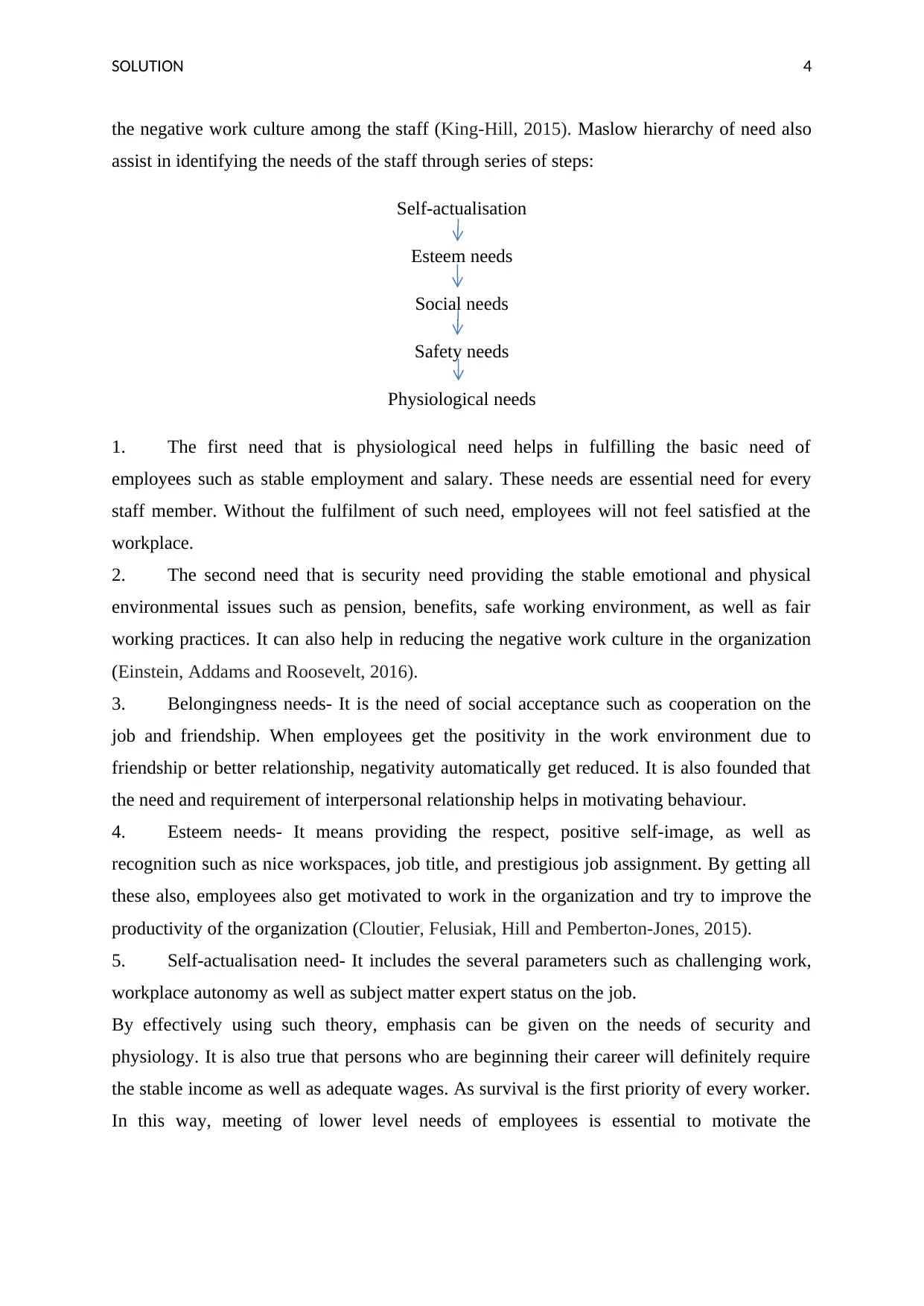
SOLUTION 4
the negative work culture among the staff (King-Hill, 2015). Maslow hierarchy of need also
assist in identifying the needs of the staff through series of steps:
Self-actualisation
Esteem needs
Social needs
Safety needs
Physiological needs
1. The first need that is physiological need helps in fulfilling the basic need of
employees such as stable employment and salary. These needs are essential need for every
staff member. Without the fulfilment of such need, employees will not feel satisfied at the
workplace.
2. The second need that is security need providing the stable emotional and physical
environmental issues such as pension, benefits, safe working environment, as well as fair
working practices. It can also help in reducing the negative work culture in the organization
(Einstein, Addams and Roosevelt, 2016).
3. Belongingness needs- It is the need of social acceptance such as cooperation on the
job and friendship. When employees get the positivity in the work environment due to
friendship or better relationship, negativity automatically get reduced. It is also founded that
the need and requirement of interpersonal relationship helps in motivating behaviour.
4. Esteem needs- It means providing the respect, positive self-image, as well as
recognition such as nice workspaces, job title, and prestigious job assignment. By getting all
these also, employees also get motivated to work in the organization and try to improve the
productivity of the organization (Cloutier, Felusiak, Hill and Pemberton-Jones, 2015).
5. Self-actualisation need- It includes the several parameters such as challenging work,
workplace autonomy as well as subject matter expert status on the job.
By effectively using such theory, emphasis can be given on the needs of security and
physiology. It is also true that persons who are beginning their career will definitely require
the stable income as well as adequate wages. As survival is the first priority of every worker.
In this way, meeting of lower level needs of employees is essential to motivate the
the negative work culture among the staff (King-Hill, 2015). Maslow hierarchy of need also
assist in identifying the needs of the staff through series of steps:
Self-actualisation
Esteem needs
Social needs
Safety needs
Physiological needs
1. The first need that is physiological need helps in fulfilling the basic need of
employees such as stable employment and salary. These needs are essential need for every
staff member. Without the fulfilment of such need, employees will not feel satisfied at the
workplace.
2. The second need that is security need providing the stable emotional and physical
environmental issues such as pension, benefits, safe working environment, as well as fair
working practices. It can also help in reducing the negative work culture in the organization
(Einstein, Addams and Roosevelt, 2016).
3. Belongingness needs- It is the need of social acceptance such as cooperation on the
job and friendship. When employees get the positivity in the work environment due to
friendship or better relationship, negativity automatically get reduced. It is also founded that
the need and requirement of interpersonal relationship helps in motivating behaviour.
4. Esteem needs- It means providing the respect, positive self-image, as well as
recognition such as nice workspaces, job title, and prestigious job assignment. By getting all
these also, employees also get motivated to work in the organization and try to improve the
productivity of the organization (Cloutier, Felusiak, Hill and Pemberton-Jones, 2015).
5. Self-actualisation need- It includes the several parameters such as challenging work,
workplace autonomy as well as subject matter expert status on the job.
By effectively using such theory, emphasis can be given on the needs of security and
physiology. It is also true that persons who are beginning their career will definitely require
the stable income as well as adequate wages. As survival is the first priority of every worker.
In this way, meeting of lower level needs of employees is essential to motivate the
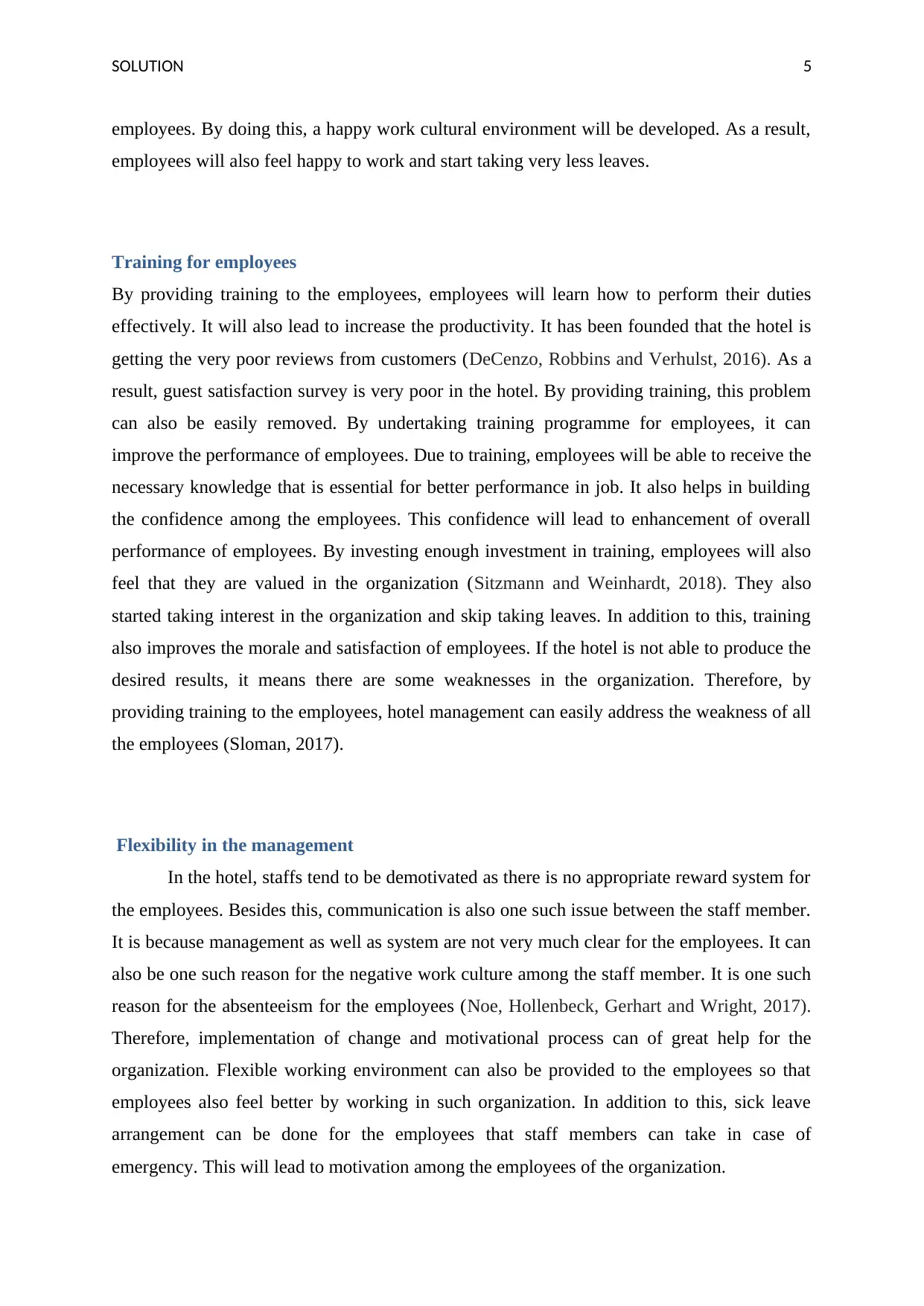
SOLUTION 5
employees. By doing this, a happy work cultural environment will be developed. As a result,
employees will also feel happy to work and start taking very less leaves.
Training for employees
By providing training to the employees, employees will learn how to perform their duties
effectively. It will also lead to increase the productivity. It has been founded that the hotel is
getting the very poor reviews from customers (DeCenzo, Robbins and Verhulst, 2016). As a
result, guest satisfaction survey is very poor in the hotel. By providing training, this problem
can also be easily removed. By undertaking training programme for employees, it can
improve the performance of employees. Due to training, employees will be able to receive the
necessary knowledge that is essential for better performance in job. It also helps in building
the confidence among the employees. This confidence will lead to enhancement of overall
performance of employees. By investing enough investment in training, employees will also
feel that they are valued in the organization (Sitzmann and Weinhardt, 2018). They also
started taking interest in the organization and skip taking leaves. In addition to this, training
also improves the morale and satisfaction of employees. If the hotel is not able to produce the
desired results, it means there are some weaknesses in the organization. Therefore, by
providing training to the employees, hotel management can easily address the weakness of all
the employees (Sloman, 2017).
Flexibility in the management
In the hotel, staffs tend to be demotivated as there is no appropriate reward system for
the employees. Besides this, communication is also one such issue between the staff member.
It is because management as well as system are not very much clear for the employees. It can
also be one such reason for the negative work culture among the staff member. It is one such
reason for the absenteeism for the employees (Noe, Hollenbeck, Gerhart and Wright, 2017).
Therefore, implementation of change and motivational process can of great help for the
organization. Flexible working environment can also be provided to the employees so that
employees also feel better by working in such organization. In addition to this, sick leave
arrangement can be done for the employees that staff members can take in case of
emergency. This will lead to motivation among the employees of the organization.
employees. By doing this, a happy work cultural environment will be developed. As a result,
employees will also feel happy to work and start taking very less leaves.
Training for employees
By providing training to the employees, employees will learn how to perform their duties
effectively. It will also lead to increase the productivity. It has been founded that the hotel is
getting the very poor reviews from customers (DeCenzo, Robbins and Verhulst, 2016). As a
result, guest satisfaction survey is very poor in the hotel. By providing training, this problem
can also be easily removed. By undertaking training programme for employees, it can
improve the performance of employees. Due to training, employees will be able to receive the
necessary knowledge that is essential for better performance in job. It also helps in building
the confidence among the employees. This confidence will lead to enhancement of overall
performance of employees. By investing enough investment in training, employees will also
feel that they are valued in the organization (Sitzmann and Weinhardt, 2018). They also
started taking interest in the organization and skip taking leaves. In addition to this, training
also improves the morale and satisfaction of employees. If the hotel is not able to produce the
desired results, it means there are some weaknesses in the organization. Therefore, by
providing training to the employees, hotel management can easily address the weakness of all
the employees (Sloman, 2017).
Flexibility in the management
In the hotel, staffs tend to be demotivated as there is no appropriate reward system for
the employees. Besides this, communication is also one such issue between the staff member.
It is because management as well as system are not very much clear for the employees. It can
also be one such reason for the negative work culture among the staff member. It is one such
reason for the absenteeism for the employees (Noe, Hollenbeck, Gerhart and Wright, 2017).
Therefore, implementation of change and motivational process can of great help for the
organization. Flexible working environment can also be provided to the employees so that
employees also feel better by working in such organization. In addition to this, sick leave
arrangement can be done for the employees that staff members can take in case of
emergency. This will lead to motivation among the employees of the organization.
⊘ This is a preview!⊘
Do you want full access?
Subscribe today to unlock all pages.

Trusted by 1+ million students worldwide
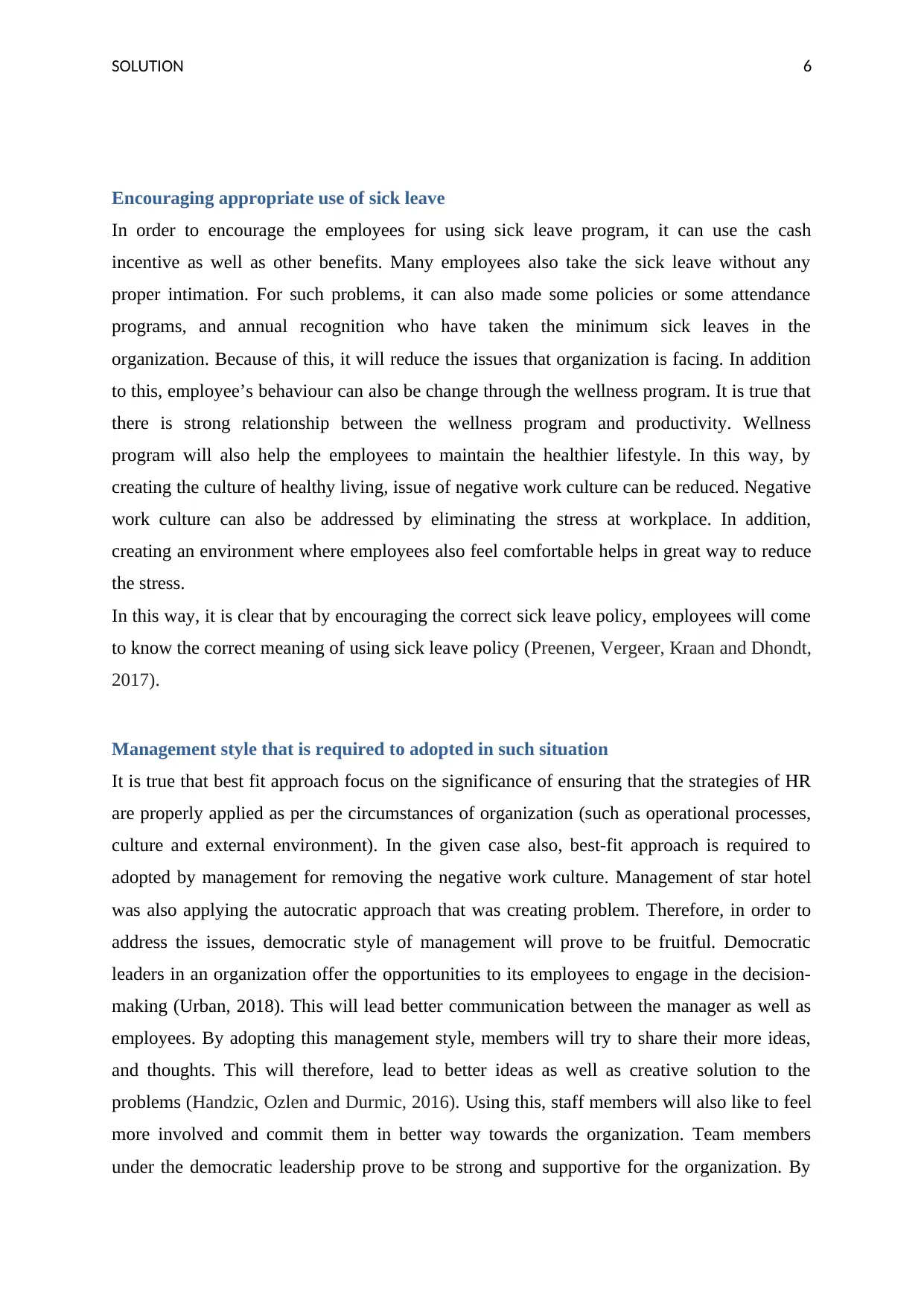
SOLUTION 6
Encouraging appropriate use of sick leave
In order to encourage the employees for using sick leave program, it can use the cash
incentive as well as other benefits. Many employees also take the sick leave without any
proper intimation. For such problems, it can also made some policies or some attendance
programs, and annual recognition who have taken the minimum sick leaves in the
organization. Because of this, it will reduce the issues that organization is facing. In addition
to this, employee’s behaviour can also be change through the wellness program. It is true that
there is strong relationship between the wellness program and productivity. Wellness
program will also help the employees to maintain the healthier lifestyle. In this way, by
creating the culture of healthy living, issue of negative work culture can be reduced. Negative
work culture can also be addressed by eliminating the stress at workplace. In addition,
creating an environment where employees also feel comfortable helps in great way to reduce
the stress.
In this way, it is clear that by encouraging the correct sick leave policy, employees will come
to know the correct meaning of using sick leave policy (Preenen, Vergeer, Kraan and Dhondt,
2017).
Management style that is required to adopted in such situation
It is true that best fit approach focus on the significance of ensuring that the strategies of HR
are properly applied as per the circumstances of organization (such as operational processes,
culture and external environment). In the given case also, best-fit approach is required to
adopted by management for removing the negative work culture. Management of star hotel
was also applying the autocratic approach that was creating problem. Therefore, in order to
address the issues, democratic style of management will prove to be fruitful. Democratic
leaders in an organization offer the opportunities to its employees to engage in the decision-
making (Urban, 2018). This will lead better communication between the manager as well as
employees. By adopting this management style, members will try to share their more ideas,
and thoughts. This will therefore, lead to better ideas as well as creative solution to the
problems (Handzic, Ozlen and Durmic, 2016). Using this, staff members will also like to feel
more involved and commit them in better way towards the organization. Team members
under the democratic leadership prove to be strong and supportive for the organization. By
Encouraging appropriate use of sick leave
In order to encourage the employees for using sick leave program, it can use the cash
incentive as well as other benefits. Many employees also take the sick leave without any
proper intimation. For such problems, it can also made some policies or some attendance
programs, and annual recognition who have taken the minimum sick leaves in the
organization. Because of this, it will reduce the issues that organization is facing. In addition
to this, employee’s behaviour can also be change through the wellness program. It is true that
there is strong relationship between the wellness program and productivity. Wellness
program will also help the employees to maintain the healthier lifestyle. In this way, by
creating the culture of healthy living, issue of negative work culture can be reduced. Negative
work culture can also be addressed by eliminating the stress at workplace. In addition,
creating an environment where employees also feel comfortable helps in great way to reduce
the stress.
In this way, it is clear that by encouraging the correct sick leave policy, employees will come
to know the correct meaning of using sick leave policy (Preenen, Vergeer, Kraan and Dhondt,
2017).
Management style that is required to adopted in such situation
It is true that best fit approach focus on the significance of ensuring that the strategies of HR
are properly applied as per the circumstances of organization (such as operational processes,
culture and external environment). In the given case also, best-fit approach is required to
adopted by management for removing the negative work culture. Management of star hotel
was also applying the autocratic approach that was creating problem. Therefore, in order to
address the issues, democratic style of management will prove to be fruitful. Democratic
leaders in an organization offer the opportunities to its employees to engage in the decision-
making (Urban, 2018). This will lead better communication between the manager as well as
employees. By adopting this management style, members will try to share their more ideas,
and thoughts. This will therefore, lead to better ideas as well as creative solution to the
problems (Handzic, Ozlen and Durmic, 2016). Using this, staff members will also like to feel
more involved and commit them in better way towards the organization. Team members
under the democratic leadership prove to be strong and supportive for the organization. By
Paraphrase This Document
Need a fresh take? Get an instant paraphrase of this document with our AI Paraphraser
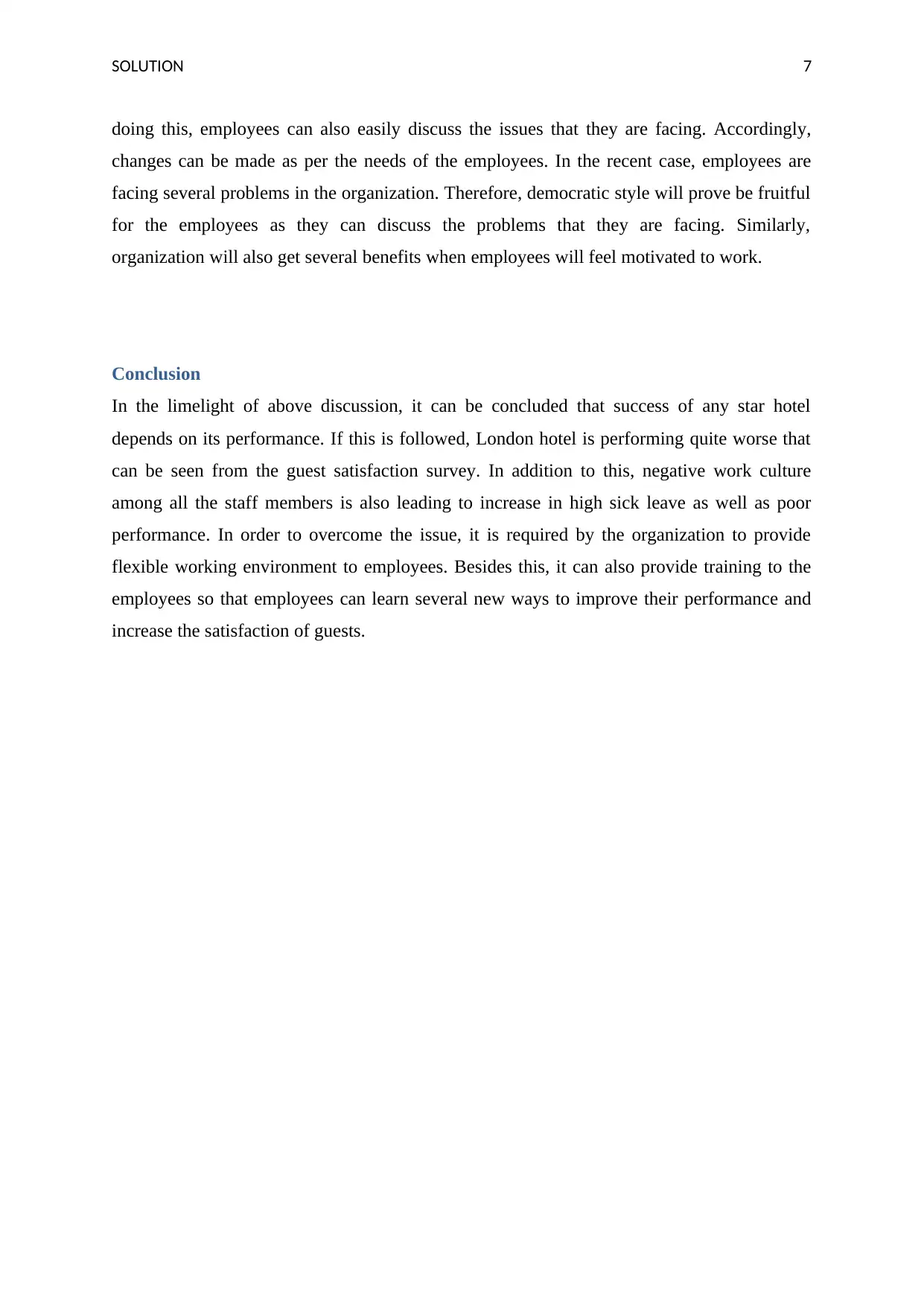
SOLUTION 7
doing this, employees can also easily discuss the issues that they are facing. Accordingly,
changes can be made as per the needs of the employees. In the recent case, employees are
facing several problems in the organization. Therefore, democratic style will prove be fruitful
for the employees as they can discuss the problems that they are facing. Similarly,
organization will also get several benefits when employees will feel motivated to work.
Conclusion
In the limelight of above discussion, it can be concluded that success of any star hotel
depends on its performance. If this is followed, London hotel is performing quite worse that
can be seen from the guest satisfaction survey. In addition to this, negative work culture
among all the staff members is also leading to increase in high sick leave as well as poor
performance. In order to overcome the issue, it is required by the organization to provide
flexible working environment to employees. Besides this, it can also provide training to the
employees so that employees can learn several new ways to improve their performance and
increase the satisfaction of guests.
doing this, employees can also easily discuss the issues that they are facing. Accordingly,
changes can be made as per the needs of the employees. In the recent case, employees are
facing several problems in the organization. Therefore, democratic style will prove be fruitful
for the employees as they can discuss the problems that they are facing. Similarly,
organization will also get several benefits when employees will feel motivated to work.
Conclusion
In the limelight of above discussion, it can be concluded that success of any star hotel
depends on its performance. If this is followed, London hotel is performing quite worse that
can be seen from the guest satisfaction survey. In addition to this, negative work culture
among all the staff members is also leading to increase in high sick leave as well as poor
performance. In order to overcome the issue, it is required by the organization to provide
flexible working environment to employees. Besides this, it can also provide training to the
employees so that employees can learn several new ways to improve their performance and
increase the satisfaction of guests.
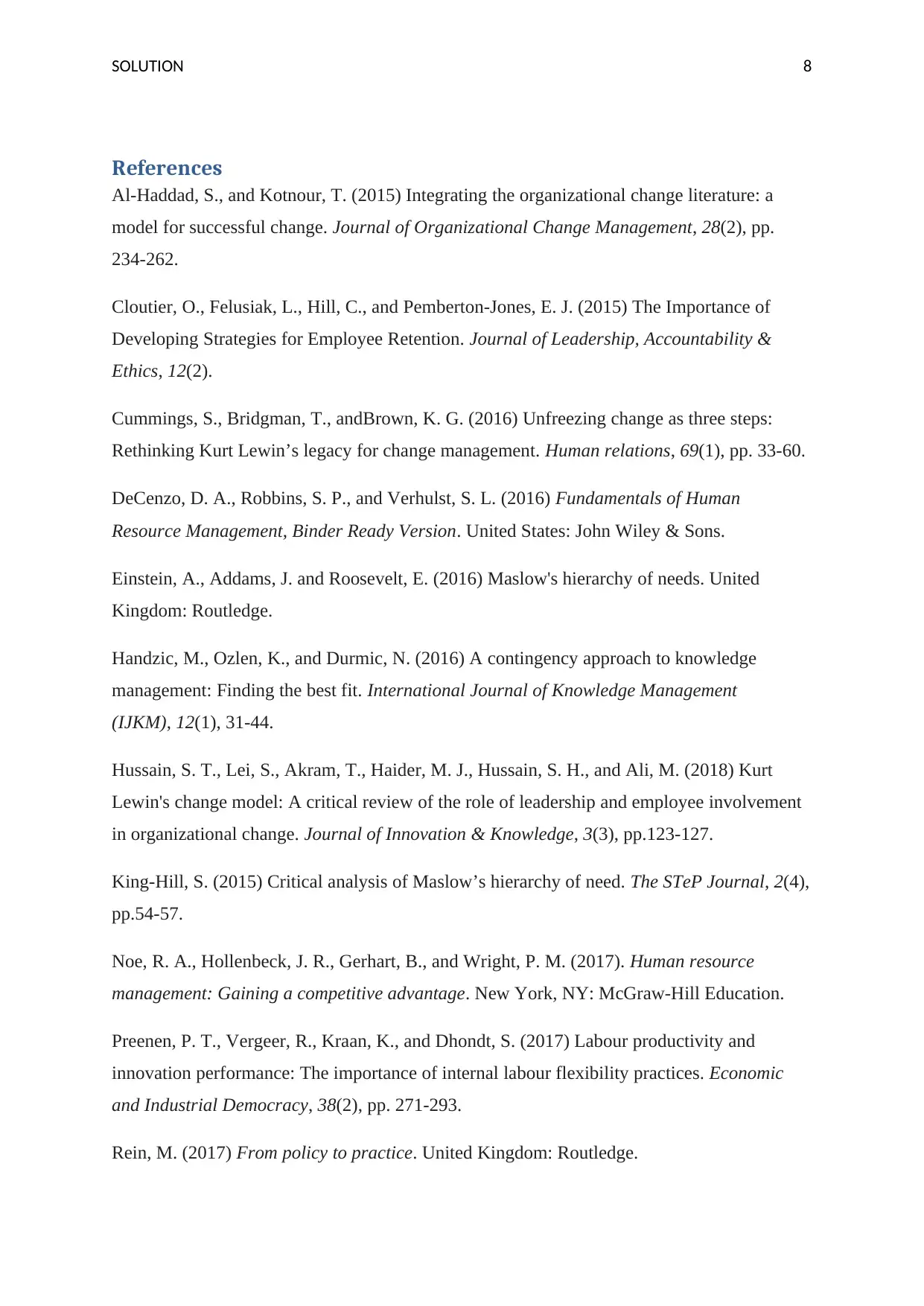
SOLUTION 8
References
Al-Haddad, S., and Kotnour, T. (2015) Integrating the organizational change literature: a
model for successful change. Journal of Organizational Change Management, 28(2), pp.
234-262.
Cloutier, O., Felusiak, L., Hill, C., and Pemberton-Jones, E. J. (2015) The Importance of
Developing Strategies for Employee Retention. Journal of Leadership, Accountability &
Ethics, 12(2).
Cummings, S., Bridgman, T., andBrown, K. G. (2016) Unfreezing change as three steps:
Rethinking Kurt Lewin’s legacy for change management. Human relations, 69(1), pp. 33-60.
DeCenzo, D. A., Robbins, S. P., and Verhulst, S. L. (2016) Fundamentals of Human
Resource Management, Binder Ready Version. United States: John Wiley & Sons.
Einstein, A., Addams, J. and Roosevelt, E. (2016) Maslow's hierarchy of needs. United
Kingdom: Routledge.
Handzic, M., Ozlen, K., and Durmic, N. (2016) A contingency approach to knowledge
management: Finding the best fit. International Journal of Knowledge Management
(IJKM), 12(1), 31-44.
Hussain, S. T., Lei, S., Akram, T., Haider, M. J., Hussain, S. H., and Ali, M. (2018) Kurt
Lewin's change model: A critical review of the role of leadership and employee involvement
in organizational change. Journal of Innovation & Knowledge, 3(3), pp.123-127.
King-Hill, S. (2015) Critical analysis of Maslow’s hierarchy of need. The STeP Journal, 2(4),
pp.54-57.
Noe, R. A., Hollenbeck, J. R., Gerhart, B., and Wright, P. M. (2017). Human resource
management: Gaining a competitive advantage. New York, NY: McGraw-Hill Education.
Preenen, P. T., Vergeer, R., Kraan, K., and Dhondt, S. (2017) Labour productivity and
innovation performance: The importance of internal labour flexibility practices. Economic
and Industrial Democracy, 38(2), pp. 271-293.
Rein, M. (2017) From policy to practice. United Kingdom: Routledge.
References
Al-Haddad, S., and Kotnour, T. (2015) Integrating the organizational change literature: a
model for successful change. Journal of Organizational Change Management, 28(2), pp.
234-262.
Cloutier, O., Felusiak, L., Hill, C., and Pemberton-Jones, E. J. (2015) The Importance of
Developing Strategies for Employee Retention. Journal of Leadership, Accountability &
Ethics, 12(2).
Cummings, S., Bridgman, T., andBrown, K. G. (2016) Unfreezing change as three steps:
Rethinking Kurt Lewin’s legacy for change management. Human relations, 69(1), pp. 33-60.
DeCenzo, D. A., Robbins, S. P., and Verhulst, S. L. (2016) Fundamentals of Human
Resource Management, Binder Ready Version. United States: John Wiley & Sons.
Einstein, A., Addams, J. and Roosevelt, E. (2016) Maslow's hierarchy of needs. United
Kingdom: Routledge.
Handzic, M., Ozlen, K., and Durmic, N. (2016) A contingency approach to knowledge
management: Finding the best fit. International Journal of Knowledge Management
(IJKM), 12(1), 31-44.
Hussain, S. T., Lei, S., Akram, T., Haider, M. J., Hussain, S. H., and Ali, M. (2018) Kurt
Lewin's change model: A critical review of the role of leadership and employee involvement
in organizational change. Journal of Innovation & Knowledge, 3(3), pp.123-127.
King-Hill, S. (2015) Critical analysis of Maslow’s hierarchy of need. The STeP Journal, 2(4),
pp.54-57.
Noe, R. A., Hollenbeck, J. R., Gerhart, B., and Wright, P. M. (2017). Human resource
management: Gaining a competitive advantage. New York, NY: McGraw-Hill Education.
Preenen, P. T., Vergeer, R., Kraan, K., and Dhondt, S. (2017) Labour productivity and
innovation performance: The importance of internal labour flexibility practices. Economic
and Industrial Democracy, 38(2), pp. 271-293.
Rein, M. (2017) From policy to practice. United Kingdom: Routledge.
⊘ This is a preview!⊘
Do you want full access?
Subscribe today to unlock all pages.

Trusted by 1+ million students worldwide
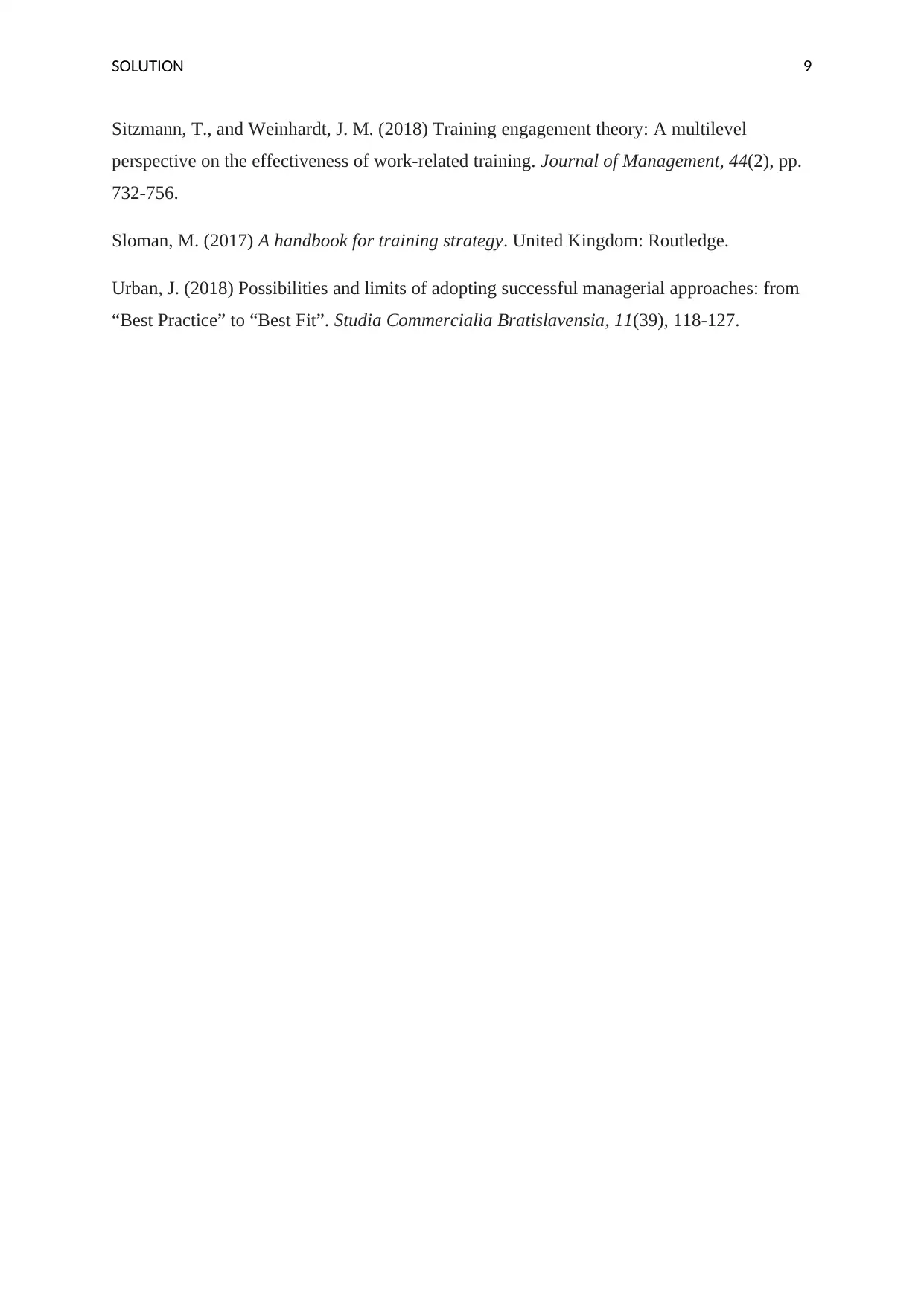
SOLUTION 9
Sitzmann, T., and Weinhardt, J. M. (2018) Training engagement theory: A multilevel
perspective on the effectiveness of work-related training. Journal of Management, 44(2), pp.
732-756.
Sloman, M. (2017) A handbook for training strategy. United Kingdom: Routledge.
Urban, J. (2018) Possibilities and limits of adopting successful managerial approaches: from
“Best Practice” to “Best Fit”. Studia Commercialia Bratislavensia, 11(39), 118-127.
Sitzmann, T., and Weinhardt, J. M. (2018) Training engagement theory: A multilevel
perspective on the effectiveness of work-related training. Journal of Management, 44(2), pp.
732-756.
Sloman, M. (2017) A handbook for training strategy. United Kingdom: Routledge.
Urban, J. (2018) Possibilities and limits of adopting successful managerial approaches: from
“Best Practice” to “Best Fit”. Studia Commercialia Bratislavensia, 11(39), 118-127.
1 out of 10
Related Documents
Your All-in-One AI-Powered Toolkit for Academic Success.
+13062052269
info@desklib.com
Available 24*7 on WhatsApp / Email
![[object Object]](/_next/static/media/star-bottom.7253800d.svg)
Unlock your academic potential
Copyright © 2020–2025 A2Z Services. All Rights Reserved. Developed and managed by ZUCOL.




